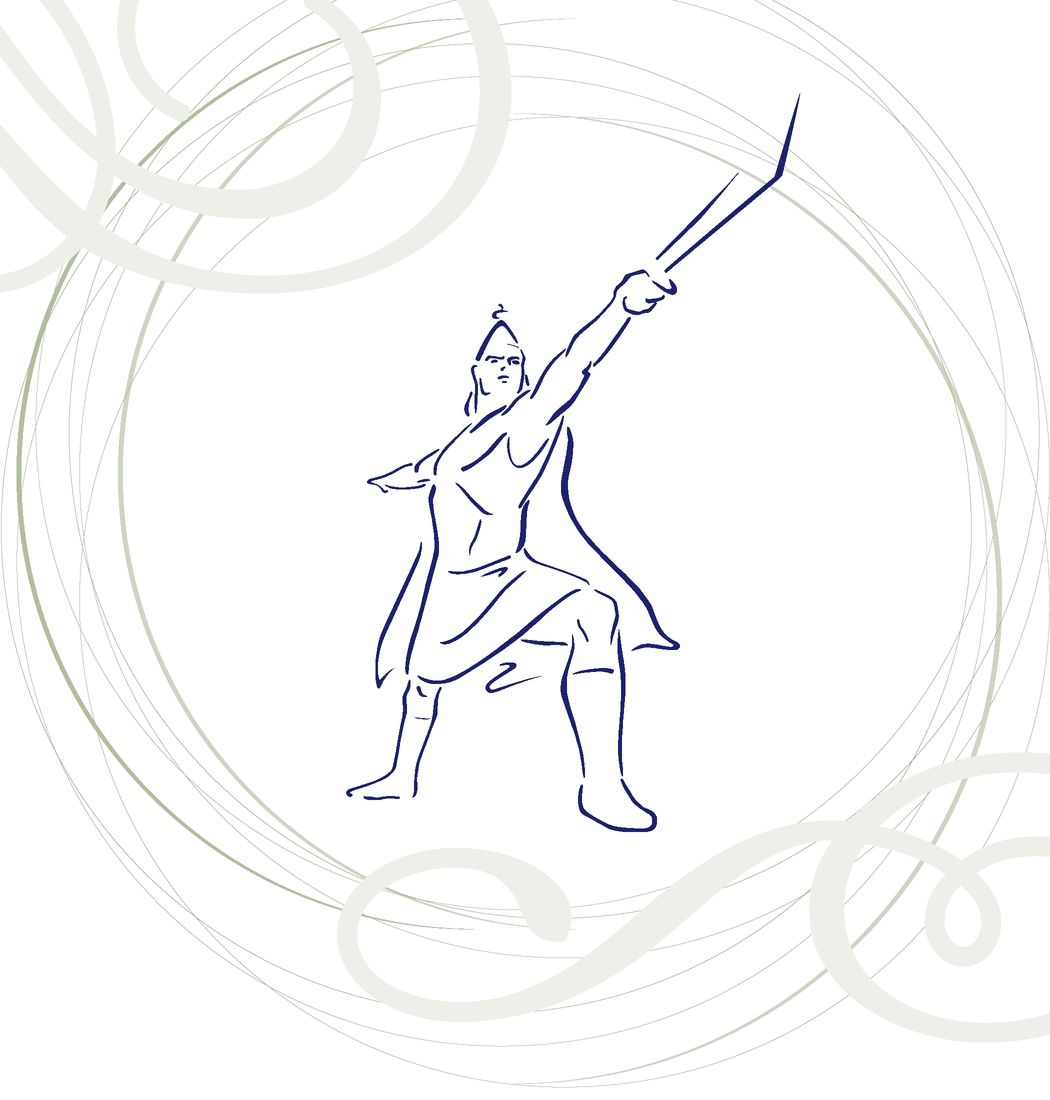virabhadrasana
WARRIOR POSES
The series of warrior poses includes three variations that could easily be considered the most iconic of the standing postures. All three are strong standing poses. The first is oriented toward the front, with arms up overhead; the second is oriented to the side, with arms outstretched; and the third is again oriented to the front, but with arms stretched forward, and the body balanced on one leg. Although the three postures are generally not taught in succession, they all fit together and illustrate the power and ferocity of the warrior.
Dreadlocked & Destructive
The great Shiva has a fierce and unending love for his consort, Shakti. Shakti has many incarnations, as the gods often do, and in her various forms she is known by different names. During one of her many lifetimes, she was known as Sati and was born to a mortal father named Daksha. Sati was incredibly beautiful and wholly devoted to Shiva. He was her secret love, and she kept this hidden within the depths of her heart while she was growing up, worshipping him and professing her love to him only in private.
Daksha wasn’t a huge fan of Shiva. His ideal mate for his daughter didn’t include a dreadlocked guy covered in ash who was known to have a bad temper and sat in meditation for thousands of years on top of a remote mountain. Not to mention his choice of clothing, which was pretty scant. Nonetheless, Sati’s heart was set upon Shiva, and she would never be happy unless they could be together.
When Sati came of age, her father had a grand party to which he invited every eligible suitor in the land—except, of course, Shiva. Well, being a clever young woman, Sati knew just how to work around her father and get what she wanted. During the party, she mixed and mingled with the other partygoers, making her father proud by feigning interest in a few of the young men. However, when the time came to choose her partner, she threw the garland she had been wearing around her neck up in the air and invoked the name of the great Shiva. He then appeared in the sky, donned the garland, and fell to Sati’s side with great joy. According to tradition, whoever wore the garland must be the one to wed the available daughter, so Daksha had no choice but to give his lovely princess to the god he despised so much.

Daksha’s fury would not go unavenged. After Sati and Shiva were wed and living happily on the mountaintop, Daksha threw yet another grand soiree, and again he made a point not to invite Shiva, which was an insult of the highest order. Sati became very upset that her father still would not accept the choice that made her so happy.
During the jubilee, Sati appeared before her father with a saddened face and sorrow in her heart. All the guests turned to see Daksha’s beautiful daughter standing and weeping before him. Daksha, who loved his daughter very much, was distraught to see her so upset but stood by his decision to continue to reject Shiva as her partner. Sati’s fury and great sadness ignited a fire that burned so brightly inside her that she went up in flames right in the middle of the party and was reduced to a pile of ashes before her father’s very eyes.
Sati’s self-immolation caused a great disturbance in the universe, which Shiva felt in his meditative state upon Mount Kailash. He knew instantly that something had happened to his beloved. When the heavenly minstrel Narada came to him with the tale of what had occurred, Shiva became absolutely furious. In his fury and rage, he stood on top of the mountain, ripped a dreadlock from his head, and threw it on the ground. With the force of his anger, this dreadlock snaked into the earth and all the way down through the mountain, only to emerge in the center of the party, right in the very spot where Sati’s ashes lay.
The dreadlock was transformed into Virabhadra, the great warrior, who rose out of the ground (think warrior 1 pose, palms together, face upturned), drew his sword (think warrior 2, arms open), and sliced off Daksha’s head. When it fell to the ground, Virabhadra bent to pick it up and reached forward to place it upon a stake (think warrior 3, arms reaching forward). This shocking act caused quite an uproar among the partygoers, who tried to flee the scene because they feared for their own heads.
In the world of the gods things can happen almost instantaneously, and this dire situation required the great Sati to secure another form very quickly so she could go reason with Shiva. She donned a new body and showed up at the party again, but this time, she scolded Shiva for beheading her father. “Look at what you’ve done!” she exclaimed to Virabhadra, knowing that Shiva would hear her on the mountaintop. “I know my father didn’t do a kind thing, but it wasn’t your place to step into the middle of it and kill him. Do you really think that is going to solve our problem and make him accept you?”
Shiva hadn’t really thought of that. He was just so angry at Daksha, he didn’t really consider how Sati would feel or that it would start a dramatic chain of events that would actually make things worse, not better. The problem was, he hadn’t thought at all.
Sati demanded, “Make this right, right now! I don’t care how you do it, just fix it.” Well, Shiva himself arrived at the party, where a few lone partygoers were peering from behind trees to see what the great would do. He came marching in with his trident in hand and waved Virabhadra aside to keep him at bay. Shiva looked around and realized immediately that Daksha’s head was not suitable for reattachment, so he found the nearest replacement, which happened to be a goat. Off came the head of the goat, and onto Daksha’s body it went. Shiva breathed a great exhale, and life returned to Daksha’s body. The object of his rage was standing in front of him, but Daksha suddenly felt grateful that Shiva had realized the error of his ways and made amends.
In his gratitude, and with the realization that he had not behaved in a dignified way toward Shiva, Daksha held one final party and made Shiva and Sati his guests of honor.
A Warrior’s Code of Behavior
Topics of conversation among yogis are often lighthearted, but the reality is that life isn’t always just butterflies and rainbows. It gets hard, and tough decisions need to be made. Challenges arise that shake us to our very core, as was the case for Shiva when he was faced with his beloved’s death at, he believed, the hands of her father. The knee-jerk reaction most of us experience is exactly that—a reaction. Often our impulses, like Shiva’s, lead us to seek revenge. We may not always act on that impulse, as Shiva did, but we may secretly want to, turning such thoughts over and over in our head.
The truth is, things rarely go as planned. For example, how much time have we spent in our mind playing out an entire argument? We think, “Okay, if he says this, then I’ll respond that way. Then, he’ll probably say that, so I’ll say this back.” In the end, the conversation rarely goes the way we want it to. We deal with disappointments and failed expectations every single day. This kind of constant stress can lead an aspiring yogi to wonder, how can we resist the impulse of a heated moment? How can we bring that bliss and simplicity we experience on our mat to the daily challenges of our lives? There is a profound aphorism in the Yoga Sutra that gives us the perfect prescription:
Maitri karuna muditopekshanam sukha dukha punya apunya visayanam bhavanatash chitta prasadanam. (YS 1.33)
“In order to preserve an elevated state of mind, be happy for those who are happy, cultivate compassion for those who are sad, feel delight for those deemed to be lucky [virtuous or righteous], and experience indifference toward those perceived to be wicked.”
Although it seems easy to be happy for those who are happy, in reality it’s not. Daksha could not be happy for his daughter, despite the fact that she had finally joined with the love that she had so long desired. Likewise, some of her potential suitors may have had a hard time feeling delighted about her good fortune in landing Shiva as a mate (little did they know that she’d been praying for him for years!).
Behaving with compassion or detachment isn’t easy either. When Sati came to Daksha in sadness because of his rejection of Shiva, he could not feel compassion for her, because he was too caught up in being right. Shiva, on the other hand, looked upon Daksha’s unkindness toward his daughter as wicked. Instead of remaining indifferent, he sought revenge and sent Virabhadra to exact it.
Even the gods seem to screw up sometimes, although their apparent mistakes are really made to teach us valuable lessons. They give hope to the rest of us yogis, who try hard every day to maintain a yogi’s state of mind. Having a sweet or uplifted outlook, which Patanjali refers to as chitta prasadanam, is really the optimal state in which to pursue a yoga practice.
We begin doing a posture in a certain way, but we continually deepen our experience of the posture in order to further our practice. It’s the same when we take our practice off the mat and become yoga warriors out in the world. Patanjali’s Yoga Sutra gives us the tools of happiness, compassion, delight, and indifference. He asks us to use them to preserve our elevated state of mind. Yoga practice really begins when things get hard—in life or on the mat.
It is not easy being a warrior, especially one who is constantly fighting against a reactive mind. Possibly the greatest lesson we can learn from Shiva and Virabhadra is that when we err, we always have the opportunity to step forward and do our best to make things right. Warrior poses are a reminder that ferocity exists not only to destroy but also to allow us sufficient strength to achieve integrity, compassion, and a loving state of mind.


